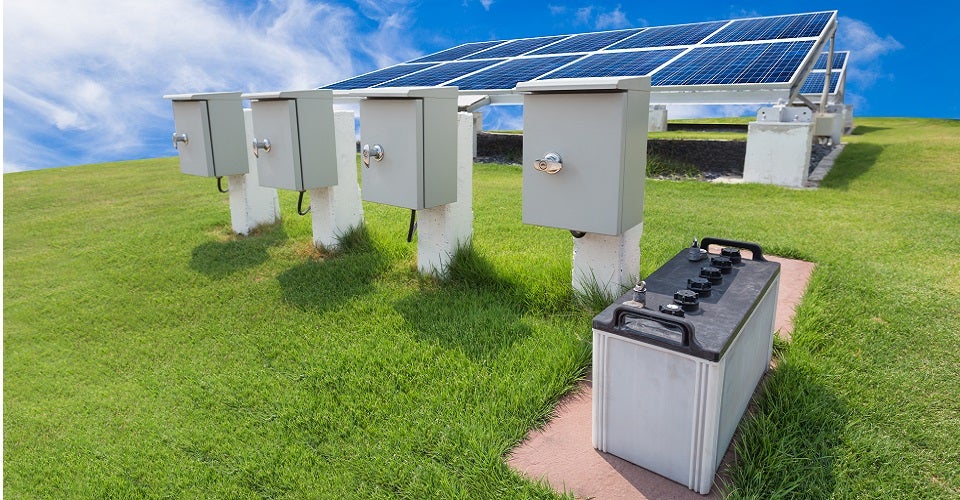
Our Editors independently research, test, and rate what we feel are the best products. We use affiliate links and may receive a small commission on purchases.
Solar batteries are a key component of any off-grid solar energy system. Without the right solar battery, your power system will be inefficient and may not be capable of providing the quantity of electricity you need at the time when you need it.
You may be planning to build a new solar power system or simply replacing the batteries in an existing system. Whatever your circumstances may be, we can help you to choose the right battery.
The solar batteries reviewed below are some of the best on the market today. However, each of them has different specifications making it better in some power systems than others. Read on to discover which top solar battery is perfect for you.
Best Solar Batteries
| Vmaxtanks VMAXSLR125 Deep Cycle Battery | Battle Born LiFePO4 Deep Cycle Battery | Renogy Deep Cycle AGM Battery | |
|---|---|---|---|
| Type: | AGM | Lithium-ion | AGM |
| Weight: | 75 Pounds | 31 Pounds | 66 Pounds |
| Capacity: | 125Ah | 100Ah | 100Ah |
| Volts: | 12V | 12V | 12V |
For more of my off-grid power recommendations, have a look through these popular Outside Pursuits guide links: Home Wind Turbines, Home Solar Panels, Solar Charge Controllers.
Quick Answer: The Best Rated Solar Batteries
- VMAX CHARGE TANK VMAXSLR125 AGM
- Battle Born LiFePO4 Deep Cycle Battery
- Renogy Deep Cycle AGM Battery
- Mighty Max SLA AGM Battery
- Ampere Time LiFePO4 Deep-Cycle Battery
- WindyNation Deep-Cycle Sealed Lead Acid Battery
- Renogy Lithium Iron Phosphate Battery
Our reviews of the top rated solar batteries with our comparison table and buyers guide will help you choose the right battery for your needs.
Solar Battery Reviews
#1. VMAX CHARGE TANK VMAXSLR125 AGM
- Type: AGM
- Size: 12.9” long x 6.8” wide x 8.7” high
- Weight: 75 lbs.
- Maximum charging current: 30A
- Capacity: 125Ah
- Volts: 12V
- Warranty: 1 year
The Vmax Charge Tank is the solar battery of choice for many people installing a new off-grid solar power system.
It boasts a float service lifespan of up to 10 years, making it competitive when compared to much more expensive lithium-ion batteries.
The Vmax Charge Tank boasts a durable, maintenance-free casing that enables it to survive in extreme environments.
It does not give off toxic fumes. However, its relatively high weight when compared to other solar batteries in this review makes it more suitable for stationary applications such as your home’s off-grid solar power system.
This solar battery provides 125Ah storage capacity, allowing you to capture more of the sun’s energy on sunny days.
Its relatively low price and reliability combined with its long lifespan make this battery an ideal choice when building a battery bank for your home.
Many solar power system installers consider this the best off-grid battery when designing a new solar power system.
#2. Battle Born LiFePO4 Deep Cycle Battery
- Type: lithium-ion
- Size: 12.75” long x 6.88” wide x 9” high
- Weight: 31 lbs.
- Maximum charging current: 100A
- Capacity: 100Ah
- Volts: 12V
- Warranty: 10 years
The Battle Born LiFePO4 is one of the most popular solar batteries available, and it’s easy to see why.
It incorporates a battery management system that protects you and it from common problems and provides an envious 100A continuous output. And if there is a sudden demand for energy, this solar battery can supply 200A for up to 30 seconds.
If you want to run a small system in your RV that relies on just one battery, this lightweight and powerful solar battery is an ideal option.
It is designed to operate well in extreme temperatures as low as -40F and as high as1580F. It also boasts a fast recharge.
The unbelievable 10-year warranty is a clear sign that this battery is designed to last. In fact, the Battle Born 100Ah 12V lithium-ion battery can reach up to 5,000 cycles if treated well.
The FiFePO4 is a “green energy” solar battery manufactured in a sustainable manner using non-toxic materials. It is also assembled in the USA, which considerably reduces the transportation carbon footprint.
With this battery, you’re not only contributing to protecting the planet by utilizing solar energy but you’re also helping through choosing a green solar battery brand. If you want to be eco-friendly, the Battle Born LiFePO4 is the best battery for solar off-grid power systems.
#3. Renogy Deep Cycle AGM Battery
- Type: AGM
- Size: 13.1” long x 6.9” wide x 8.6” high
- Weight: 66 lbs.
- Maximum charging current: 30A
- Capacity: 100Ah
- Volts: 12V
- Warranty: 2-years material warranty
The Renogy Deep Cycle Battery was specially designed with off-grid solar power systems and marine power systems in mind.
Its tough casing makes it leak-proof and maintenance-free. This solar battery is reliable and practical for any solar power system.
The proprietary electrolyte inside this AGM solar battery enables discharge at temperatures as low as 320F.
The battery’s high purity materials keep the monthly self-discharge rates under 3% at its optimum running temperature of 770F.
Renogy also manufactures battery interconnect cables making it simple for you to connect several of these batteries in parallel or series.
With a 2-years material warranty, this solar battery also provides you with peace of mind. The Renogy Deep Cycle Battery is one of the best batteries for solar power storage.
#4. Mighty Max SLA AGM Battery
- Type: AGM
- Size: 12.17” long x 6.61” wide x 8.3” high
- Weight: 64 lbs.
- Maximum charging current: 30A
- Capacity: 100Ah
- Volts: 12V
- Warranty: 1 year
The Mighty Max battery performs well within a wide temperature range. It charges effectively in ambient temperatures of between 140F and 1400F.
And when you need to draw that power at night, it discharges at temperatures down to -40F! That means you can use this solar battery anywhere from Alaska to Florida.
The quality sealed unit of this AGM solar battery enables it to resist high vibrations, making it perfect in situations where you’re off-roading or in marine applications.
The valve-regulated design means it won’t leak so it is maintenance-free and can be used in enclosed environments.
The Mighty Max solar battery provides a consistent supply of power, and its price won’t break the bank. One possible weakness with the design is in the terminals, which can snap if you torque down a bolt too tightly.
The answer is simply not to twist too hard during installation.
The 1-year warranty gives you confidence that this battery will perform as it should. These are the best batteries for solar off-grid power systems in hostile environments where your system may need to work in extreme temperatures or in a vibrating vehicle.
#5. Ampere Time LiFePO4 Deep-Cycle Battery
- Type: lithium-ion
- Size: 12.99” long x 6.82” wide x 8.48” high
- Weight: 25.5 lbs.
- Maximum charging current: 50A
- Capacity: 100Ah
- Volts: 12V
- Warranty: 5 years
The Ampere Time LiFePO4 is incredibly lightweight. It is the lightest battery in this review.
If your off-grid solar power system is installed somewhere where weight is an important factor, such as in your RV, then this lithium-ion battery is an ideal choice.
An innovative Battery Management System provides protection from low temperatures, short circuit, overheating, overloading, and overcharge. It offers a 10-years lifespan with a 100A continuous discharge current.
The Ampere Time LiFePO4 comes with an enviable 5-years warranty, and Amazon reviewers have commented on the manufacturer’s great customer service team. It is the highest-rated solar battery on Amazon with a rating of 4.9 out of 5.
Ampere Time is not one of the better-known manufacturers, and this battery does not have as high a capacity as some other batteries in this review.
However, its durable and super lightweight design makes this deep-cycle battery the best battery for your solar system if keeping things light is more important than capacity.
#6. WindyNation Deep-Cycle Sealed Lead Acid Battery
- Type: AGM
- Size: 13” long x 6.8” wide x 8.7” high
- Weight: 67 lbs.
- Maximum charging current: 30A
- Capacity: 100Ah
- Volts: 12V
- Warranty: 1 year
If you’re searching for an affordable deep-cycle battery specially designed for an off-grid solar power system, look no further than the WindyNation Deep-Cycle Sealed Lead Acid Battery.
This deep-cycle battery features a sealed and maintenance-free design that makes it leakproof, so it can be mounted in any position without any loss in electrolyte capacity.
Its heavy-duty plates enable repeated charge and recharge through its float service lifespan of up to 12 years.
The WindyNation Deep-Cycle Sealed Lead Acid Battery is manufactured using pure virgin lead to yield a low self-discharge rate.
Its AGM design offers a longer lifespan and superior performance compared to other lead-acid batteries.
The 1-year warranty covers full replacement of faulty accessories and free repairs, demonstrating the manufacturer’s confidence that this is the best solar battery you can purchase in this price range.
#7. Renogy Lithium Iron Phosphate Battery
- Type: lithium-ion
- Size: 10.6” long x 6.1” wide x 13.7” high
- Weight: 46.3 lbs.
- Maximum charging current: 85A
- Capacity: 170Ah
- Volts: 12V
- Warranty: 5-years prorated warranty
This is another quality battery from Renogy. The Renogy Lithium Iron Phosphate Battery is lightweight and stores a lot of energy for its size, making it ideal for boondocking in your RV.
It also works well with solar panels and recharges fast. This is a sealed, maintenance-free battery with a long shelf life.
It features many built-in safeguards, including automatic equalization of battery pack capacity, short circuit protection, high-temperature protection, low-temperature protection, over high current protection, low voltage protection, and high voltage protection.
On the negative side, the Renogy Lithium Iron Phosphate Battery is more expensive than the other batteries reviewed. It’s a case of you get what you pay for.
However, you can get away with installing one of these batteries in place of multiple lead-acid batteries for boondocking, so you must factor that in when deciding which is the more expensive option.
The 5-year warranty is a clear indication of this battery’s durability. You can purchase cheaper lithium-ion batteries with similar specifications but without a guarantee, which makes you wonder what the other manufacturers are worried about.
Perhaps its best selling point is the Renogy Lithium Iron Phosphate Battery’s amazing 170Ah capacity. If you can only fit one battery into your RV, this lithium-ion solar battery can store more energy than any other solar battery in this review.
That makes it the best lithium ion solar battery for boondocking or marine applications.
Solar Battery Comparison Table
| Solar Battery | Type | Weight | Capacity | Volts | |
|---|---|---|---|---|---|
| VMAX VMAXSLR125 AGM | AGM | 75 lbs | 125Ah | 12V | |
| Battle Born LiFePO4 Deep Cycle Battery | lithium-ion | 31 lbs | 100Ah | 12V | |
| Renogy Deep Cycle AGM Battery | AGM | 66 lbs | 100Ah | 12V | |
| Mighty Max SLA AGM Battery | AGM | 64 lbs | 100Ah | 12V | |
| Ampere Time LiFePO4 Battery | lithium-ion | 25.5 lbs | 100Ah | 12V | |
| WindyNation Deep-Cycle Battery | AGM | 67 lbs | 100Ah | 12V | |
| Renogy Lithium Battery | lithium-ion | 46.3 lbs | 170Ah | 12V |
How to Choose the Best Solar Battery – Buying Guide
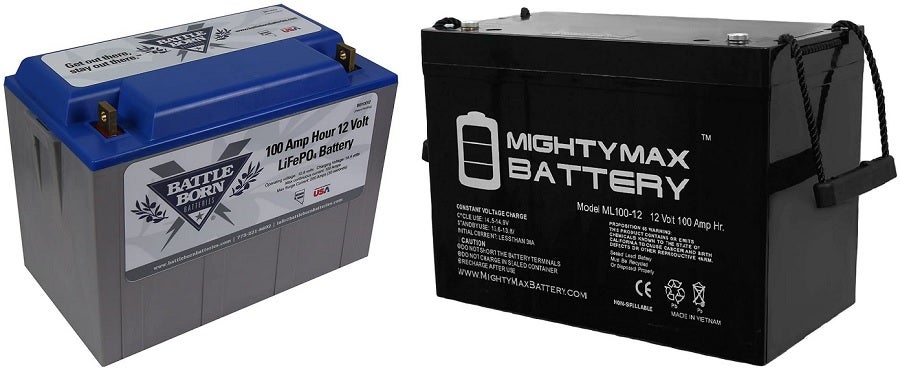
Now that you’ve read about the best solar power batteries on the market, it’s time to decide which one is right for your off-grid solar power system. This is not a “one size fits all” situation. Different batteries are better for different situations.
This buying guide tells you everything you need to know about solar batteries so you can make an informed decision about which solar battery is best for you.
What is a solar battery?
An off-grid solar power system uses a solar panel (or bank of solar panels) to generate electricity that you can use to run electrical appliances. However, a solar panel produces the most electricity when it is sunny and none when it is dark.
If you want to store the electricity produced when it is sunny to use when it grows dark, you need a solar battery. A solar battery is a deep cycle battery designed to be discharged and recharged in many cycles over and over again. It can provide a steady current over a long period of time.
A deep-cycle solar battery looks like a car battery but is designed to charge when you have excess solar-generated electricity and slowly discharge when you need to use that electricity. This empowers you to use solar-generated electricity at the flip of a switch at any time of day or night.
Types of Solar Batteries
Batteries have been around for a long time, but recent developments have made them lighter, more powerful, and more efficient. There are currently 4 main kinds of solar batteries.
Flooded Lead Acid Batteries
Wet cells have been around since the dawn of electricity and are still used in some off-grid power systems. Their main advantages are that they are affordable, reliable, and safe. However, they are bulky, corrosive, give off hydrogen gas, and can leak. They also require regular maintenance.
You must pour water into a lead-acid battery every 3 months to ensure the internal plates remain flooded. You must keep them ventilated to prevent a build-up of gas. These batteries are also not as efficient as more modern designs and will require replacing much sooner.
AGM: Absorbent Glass Mat Batteries
AGM batteries are sealed lead-acid batteries that are leak-proof and do not usually require ventilation or regular maintenance. They are resistant to cold weather and more lightweight than traditional lead-acid batteries.
Their lower internal resistance means they can hold a charge for longer and endure higher temperatures. They are also reliable, affordable, and have a longer lifespan than lead-acid batteries.
Gel Batteries
Gel batteries are also sealed lead-acid batteries. They use a thickening agent to turn the electrolyte into a gel. These batteries are durable and require no maintenance. They work well in both cold and hot temperatures and have a long lifespan. However, they are more expensive than other kinds of lead-acid batteries and have a disappointingly low Amp Hour capacity.
Lithium-ion Batteries
Lithium-ion batteries use newer technology that makes them more lightweight than lead-acid batteries. The advantages of lithium-ion batteries are that they make more efficient use of power, need no maintenance, don’t give off gases, offer a deeper discharge, have a larger energy storage capacity, and last longer.
With all these benefits, you’re probably wondering why lithium-ion batteries are not used in all off-grid solar power systems. They are relatively expensive. When you might pay between $200 and $300 for an AGM battery, you’ll pay around $1,500 for a comparable lithium-ion battery.
What to Look for in a Solar Battery
Before you choose the best solar deep cycle battery for your off-grid solar power system, you need to consider several factors:
- Your energy requirement
- Voltage
- Capacity
- Size & weight
- Charging time
- Temperature range
- Lifespan
- Manufacturer’s warranty
- Cost
Energy Requirement
You may have designed your off-grid solar power system to provide electricity for your home, business, vacation property, or RV. Each of these will require different quantities of energy. In order to determine what size and quantity of batteries you need, you must first calculate your energy requirement.
Find out the power rating of every appliance you plan to use and estimate how much you will use it each day. Use that information to perform this calculation:
WATT HOUR = POWER RATING x HOURS USED
This will give you the energy requirement of the appliance. Add together the requirement of all your appliances to learn the total demand of your system.
Once you know the required Watt Hours, divide it by the voltage of your system to discover the required battery capacity. For example, if your RV’s appliances require 2,000 Watt Hours of energy per day and your system will run on 12V, you will require a solar battery with a capacity of (2,000/12=) 167Ah or a bank of solar batteries that provides 167Ah.
When working out your energy requirement, remember that there will be seasonal differences. For example, in Florida, the peak energy requirement will be in summer for air-conditioning while in northerly locations it will likely be in winter for heating. You need to design your system to cope with the peak demand level.
Voltage
All off-grid solar power systems run on a specific voltage. This may be 12V, 24V, or 48V. Small systems, such as in an RV, typically run on a 12V system and can use a single 12V battery. Larger systems, such as in a house, often use 24V or 48V.
You must decide what voltage you plan to use before installing your power system and buy a battery or a group of batteries connected in series to match that voltage. If you are purchasing a battery for an existing system, your new battery (or batteries) must be the same voltage as the system.
Capacity
The capacity of a solar battery is stated in Amp Hours (Ah). This tells you how much energy can be stored by that battery. If a battery has a capacity of 100Ah, it can provide a current of 1Amp at a useable voltage for 100 hours. If you require a current of 5Amps, the same battery will provide a 5Amp current for (100/5=) 20 hours.
The more appliances you use, the more current you draw, and the quicker you will drain the battery. If you plan on using a lot of appliances, you will need to purchase a battery with a higher capacity or build a bank of batteries linked in series or parallel.
A lithium-ion battery usually has a higher capacity than a similar-sized lead-acid battery, enabling you to use one lithium-ion battery where you would use two or more lead-acid batteries.
Size & weight
If your power system must squeeze into a small space or is fitted to a vehicle, size and weight will be a factor in your selection process.
For example, if you are fitting a solar power system to your RV, you won’t want to find space for 5 large batteries, and heavy batteries will significantly increase your gas expenses. Where you have limited space, lithium-ion batteries are best.
Charging time
Each battery has a different charging rate. Some solar batteries charge quickly and others slowly. If you live in an area with a limited amount of sunshine, you will require a battery that charges as quickly as possible. If you live in a perpetually sunny area, charging time is a less important factor when choosing your solar battery.
Temperature Range
Different solar batteries are designed to work within different temperature ranges. Some better designs incorporate safety cut-offs to stop them operating when the ambient temperature around them strays from that range.
So, if you are planning to use your off-grid power system in a location where the temperatures are either unusually high or low, you should ensure the solar battery you choose is designed to work at that temperature.
Lifespan
A solar battery is only useful while it can hold a usable charge. Typically, a solar battery will have a useable lifespan of between 5 and 15 years depending upon what kind of battery it is. Solar panels last longer, so you will definitely need to replace your solar batteries at some point during the lifespan of your off-grid power system.
Traditional lead-acid batteries only last between 3 and 5 years. AGM and Gel batteries last significantly longer. Lithium-ion batteries offer superior longevity, often between 10 and 15 years.
Manufacturer’s Warranty
Solar batteries are relatively expensive, so you want some assurance that the battery you choose works properly and is free from defects. The more expensive the battery is, the longer and more comprehensive the warranty should be.
Avoid batteries that don’t come with a warranty or come with a warranty that does not reflect their cost and the manufacturer’s claims about their performance.
Cost
When you first install a solar power system, all the cost is up-front, and the benefit is stretched out over a long time. This means that the initial set-up costs are a significant influence in establishing a budget for your solar battery.
If you have a tight budget, you can purchase a cheaper battery now and replace it with a more expensive battery after its useful life is over.
However, cost and quality are inversely proportional. The more you pay, the better the battery. If you have the money to invest now, you’d be better off in the long term buying the best battery you can afford.
A key factor to bear in mind is that a cheap lead-acid battery that lasts 5 years will need to be replaced twice during the time that a good-quality lithium-ion battery will continue to operate. T
This means that when comparing costs, triple the cost of the lead-acid battery and add a little more for installation costs.
How to Wire a Solar Battery Bank
Solar Battery FAQs
Q: What is the best battery for solar power?
A: A deep cycle battery is best for your off-grid solar power system. The four common kinds of deep cycle battery for power systems are lead-acid, AGM, gel, and lithium-ion batteries. Lithium-ion batteries are the best but also the most expensive. You must weigh the costs against the benefits when deciding what kind of battery to purchase for your system.
Q: What is the lifespan of a solar battery?
A: Between 5 and 15 years depending upon the type, the manufacturer, and the solar battery’s design. The lifespan can be increased by following the manufacturer’s guidelines regarding installation, useable temperature range, maintenance, and good charging and discharging discipline.
Q: How many batteries do I need for a 5000 watt inverter?
A: The quantity of batteries is not entirely dependent on the inverter size. It also relates to the input voltage of the inverter, the system’s energy requirement, and the size and capacity of the batteries.
The short answer is that if you are running your system on 48V and require 40,000 Watt Hours of energy, you will require 8 x 130Ah 12V solar batteries connected in two parallel rows with 4 batteries in series in each row. If in any doubt, consult with a solar power system installation expert.
Q: How many batteries can a 100 Watt solar panel charge?
A: Again, this question is not so straightforward as it seems because there are many other factors you need to take into account. These include the capacity of the batteries, the voltage of your system, your location and its average hours of sunlight, the temperature of the location where your batteries are, and the efficiency of your solar power system.
In theory, a 100W panel produces 100 Watt Hours of energy for each hour of sunshine. If your panel is tilted at the most efficient angle during 6 hours of bright sunshine, you’ll get (100x6=) 600 Watt Hours of energy. In reality, there are inefficiencies in any system.
There will be a drop in voltage across the electric cables, losses due to resistance in the charge controller, and dust on the solar panel can reduce the electricity generated.
As a rule of thumb, assume you’ll only get two-thirds of the energy you might expect. That means (600x2/3=) 400 Watt Hours of energy. If you are running your system on 12V, that means (400/12=) 33.3Ah of energy needs storing. However, you won’t want to deplete your battery when you’re drawing power because that shortens its lifespan.
That means you’ll need to keep your battery half full at all times, and you can only store half of its capacity every day. As a rule of thumb, you require a battery with twice the storage capacity as you require, so (33.3x2=) a battery with a capacity of 66.6Ah.
When a battery is stored below its optimum temperature range, this reduces the amount of energy it can store, so you’ll require more batteries. However, with this simple example, a single 100Ah 12V battery will be sufficient to store the electricity generated by a single 100W solar panel.
Q: How many solar batteries are needed to power a house?
A: The average American home uses approximately 30,060 Watt Hours per day according to the US Energy Information Administration. If you require 30,060Wh per day and your system runs on 48V, you will require a battery bank that provides at least (30,060/48=) 626.25Ah of storage.
The easiest way to do this would be to purchase 8 x 100Ah 12V solar batteries. You would need to connect 4 solar batteries in series to be compatible with the 48V power system, and you would need to connect 2 of these 4-battery groupings in parallel rows to provide you with a total 800Ah capacity.
This is more than the 626.25Ah requirement, but this excess capacity would enable you to store more on exceptionally sunny days and provide more energy when your demand is higher than usual.
If in any doubt about how many batteries you require, it is always best to consult an expert solar power system installer.
The Final Word
You now know a lot about solar batteries. If you want to design an off-grid solar power system that saves you a lot of money and uses renewable energy that is good for the environment, you will need solar batteries. However, you must choose the batteries that are best for your unique situation.
I hope this buying guide assists you in identifying the solar batteries you need to install in your off-grid solar power system. Please leave comments below about your own experience with replacing solar batteries in existing power systems or designing your own new system.
How We Researched
To come up with the top solar batteries, we researched a variety of sources for reviews such as Home Depot, Lowes, Target and Wayfair along with our own personal experience.
We also consulted online magazines for product research and reviews to get as much unbiased information as we could. To help weed out fake reviews we used Fakespot.com to make sure we only looked at genuine reviews.
With so much quality gear available, we had to narrow it down based on what we felt were the best options were for the price. The staff authors have a wide and varied background in yard design gardening and home repairs.
The authors have decades of experience and are eager to share their knowledge with readers.
To help narrow down the selection we used personal experiences along with recommendations from gardening enthusiasts, bloggers and contractors.
After extensive research, we came up with our list to help you choose the right one for you.

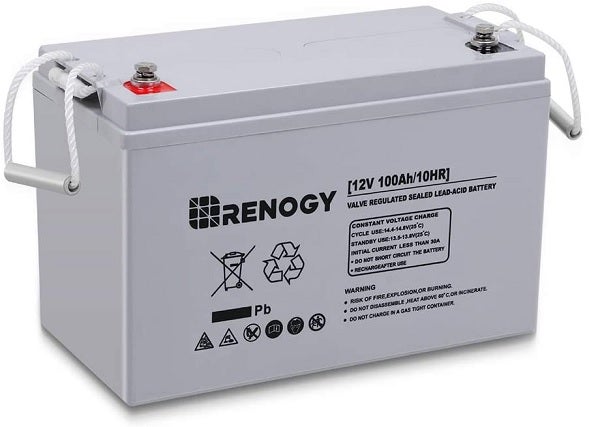
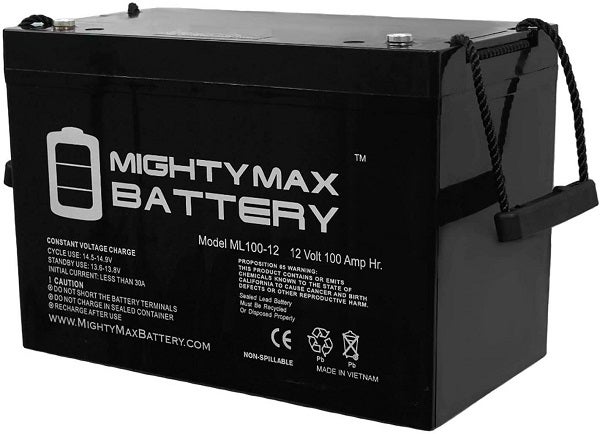
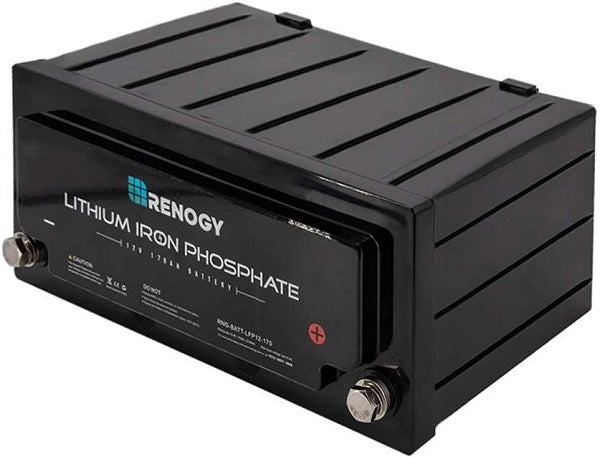
i need to buy solar panel, solar battery and inverter please assist